Review of Passive Shielding Materials for High-Energy Charged Particles in Earth’s Orbit
Abstract
1. Introduction
2. Environment of High-Energy Charged Particles in Earth’s Orbit
2.1. Classification of Earth’s Orbits
- (1)
- The LEO extends from ≈400 km to 2000 km above the Earth’s surface. Numerous small satellites are deployed in this region to facilitate closer Earth observations and Remote Sens [17,18]. The South Atlantic Anomaly is a prominent feature in this area, characterized by elevated radiation levels due to the offset and tilt of the geomagnetic axis relative to Earth’s rotational axis [19]. In addition to the SAA, the polar horns also contribute to radiation analysis at the lower altitudes (e.g., orbits similar to the International Space Station). The polar horns are segments of the outer radiation belts that are in close proximity to Earth [20,21].
- (2)
- The MEO spans an altitude range of 2000 km to 36,000 km. These orbits are situated near the center of Earth’s outer radiation belt, presenting a more intense radiation environment. This radiation can induce SEUs and latch-up phenomena in large-scale integrated electronic components, causing interference and introducing uncertain radiobiological effects [22,23,24].
- (3)
- The GEO is located at an altitude of >36,000 km. Cosmic rays play a significant role in this orbit. Although the fluxes of these particles are relatively low, they include heavy and energetic ions (e.g., iron), producing intense ionization as they traverse matter. Shielding against these ions is challenging, making them a substantial hazard. Similarly to other orbits, they can trigger SEUs and latch-up in large-scale integrated electronic components to induce interference and uncertain radiobiological effects [25,26].
2.2. Radiation Environment in Earth’s Orbit
- (1)
- The inner radiation belt is located at an altitude of ≈1000 km to 6000 km above the Earth’s surface, with a magnetic shell number (L) ranging from about 1.2 to 2. It is primarily composed of high-energy protons with energies ranging from 10 MeV to 100 MeV. Additionally, the inner radiation belt also contains lower-energy electrons, typically in the range of 10 keV to 100 keV. The inner radiation belt is relatively stable, with its particle distribution and intensity being less affected by solar activity and geomagnetic activity [43].
- (2)
- The outer radiation belt is situated at an altitude of ≈13,000 km to 60,000 km above the Earth’s surface, with a magnetic shell number (L) ranging from about 3 to 8. It is mainly composed of high-energy electrons with energies ranging from 1 MeV to 10 MeV. The outer radiation belt also contains a small number of protons, but their energies and distribution differ from those in the inner radiation belt. The particle flux and distribution in the outer radiation belt are highly dynamic and significantly influenced by space weather events (i.e., geomagnetic storms and substorms) [44,45,46,47,48]. For example, during geomagnetic storms, the flux of high-energy electrons in the outer radiation belt can vary by several orders of magnitude within a few hours to a few days.
2.3. Negative Impacts of the Radiation Environment on Normal Operation of Satellites
- (1)
- Displacement Effects: High-energy particles can create lattice defects in the functional parts of devices when they enter. These lattice defects can lead to the degradation of device performance parameters (such as the conversion efficiency of photoelectric-sensitive devices) and gradual loss of functionality [51]. For example, when high-energy protons hit Si-based semiconductor materials, they can create defects in the lattice, reducing the material’s electrical performance.
- (2)
- Ionization Effects: When charged particles enter electronic components, they ionize the bound electrons through an ionization process, generating a large number of electron–hole pairs. The ionization effect has little impact on metals, because the electronic states of electrons and holes in the conduction band of metals are already abundant. The increase in numbers due to ionization is insufficient to cause changes in their electrical properties. For semiconductors and insulators, the transition of electrons from the valence band to the conduction band should affect their electrical, chemical, and physical–mechanical properties. These electron–hole pairs can interfere with the normal operation of electronic components, leading to increased signal noise, performance degradation, and even complete failure [52,53,54]. For example, in semiconductor devices, ionization effects can increase the leakage current and reduce the switching performance of devices.
- (3)
- Single-Event Effects: The single-event effect (SEE) refers to the phenomenon where the state of a microelectronic device undergoes an abnormal change due to ionization or nuclear reactions when a single high-energy particle (e.g., the proton, heavy ion, or electron) passes through the sensitive region of the device. High-energy particles can generate mobile charges in sensitive areas of devices, causing logic errors, latch-up, voltage drift, and device burnout in digital integrated circuits. The types of single-event effects include the SEU, single-event latch-up (SEL), single-event burnout (SEB), and single-event gate rupture (SEGR). SEEs are one of the most common radiation damages in spacecraft electronic systems and can lead to sudden system crashes, data loss, or erroneous operations.
- (4)
- Charging/Discharging Effects: Charged particles can accumulate on the surface of spacecraft, forming high electric potentials. When the potential difference between different parts of a charged spacecraft exceeds a critical value, discharge phenomena can occur. The discharge process can release charges, heat, electromagnetic pulses, and glow, potentially altering the performance of the materials at the discharge site. Moreover, charges and electromagnetic pulses can directly or indirectly enter the electronic circuits or electrical systems of spacecraft, causing fatal damage to their safe operation.
- (5)
- Statistics show that up to 70% of in-orbit satellite failures are induced by the high-energy particle radiation environment in space [55,56]. For example, China’s “Fengyun-1B” meteorological satellite experienced multiple SEUs caused by high-energy particles in space after 165 days in orbit, leading to sudden failures of the onboard computer and premature failure. Additionally, the space radiation environment is closely related to the solar activity cycle. In 2003, frequent solar activity led to numerous in-orbit anomalies in spacecraft. Among these anomalies, most were temporary and self-recoverable. For instance, the US “Chandra” X-ray Observatory experienced an anomaly on 24 October 2003, but resumed normal operation on the 25th. However, some spacecraft suffered permanent failures. For example, Japan’s “Adeos2” satellite entered safe mode due to radiation effects, and it was eventually scrapped due to power supply failure. The impact of space radiation effects caused the “Adeos2” satellite to operate for only 10 months in orbit, which was three years less than its planned lifespan.
- (6)
- Therefore, how to protect against radiation is an important issue in satellite engineering, and the study and use of materials with high shielding capabilities are key to ensuring the normal service of satellites.
2.4. Radiation Protection Measures
- (1)
- Electric Field Shielding: This involves using electric fields to generate a bias that prevents or deflects the motion of charged particles. By applying an appropriate electric field to the surface of a spacecraft, the trajectory of charged particles can be altered to divert them away from critical components of the spacecraft.
- (2)
- Magnetic Field Shielding: This involves using magnetic fields to change the direction of incoming particles to provide shielding. Magnetic field shielding can be achieved by placing a magnetic field generator around the spacecraft, thereby deflecting high-energy charged particles and reducing their direct impact on the spacecraft.
- (3)
- Fault-Tolerant Computing: This includes dual-system configurations, also known as computer fault-tolerant technology. By incorporating fault tolerance and error correction capabilities, computers can continue to operate normally when errors occur or remain unaffected by errors for a certain period of time.
- (4)
- Protective Circuitry: This involves using ground-based remote control or an automatic system protection mechanism to cut off power supply. The system can then resume operation once the space environment improves. This method can protect electronics from damage when the radiation environment deteriorates.
- (5)
- Electronic Component Packaging Shielding: This involves encapsulating electronic components with specialized materials or structures to protect them from external electromagnetic interference, radiation, and environmental factors, while also preventing the emission of electromagnetic signals from the components themselves.
- (6)
- Special Location Mass Shielding: This refers to the application of targeted shielding measures to specific areas or components that are vulnerable to electromagnetic interference or radiation, ensuring the integrity and effectiveness of the overall shielding system.
2.5. Monte Carlo Simulations
3. Passive Shielding Materials
3.1. Proton Shielding Materials
3.1.1. Traditional Proton Shielding Materials
- (1)
- Polyethylene: Polyethylene has a high content of low-Z elements (C and H), effectively slowing down protons and reducing their radiation damage. Furthermore, polyethylene has a low density, is easy to process, and has good mechanical properties (i.e., flexibility and impact resistance). Therefore, it is extensively utilized to fabricate shielding structures of various shapes and sizes, making it adaptable to intricate spatial arrangements. Meanwhile, the high impact resistance and good mechanical properties of polyethylene enable it to endure mechanical impacts and vibrations during operation, guaranteeing the stability of shielding effectiveness.
- (2)
- Al: Al and alloys are easily processed and have relatively higher mechanical strength, meeting the higher structural shielding needs. For example, Sajid et al. [63] studied the shielding performance of Al layers, using the South Atlantic Anomaly as a typical case. They found that the maximum dose rate was significantly reduced from 10 rad/s to 0.01 rad/s after adding an Al shielding layer. Through Monte Carlo simulation, the protective performances of Al layers with different areal densities were evaluated. For a satellite orbit in LEO on a 3-year mission (Figure 2), the results indicated that a shield thickness of 3 mm attenuated the TID (Total Ionizing Dose) to less than 10 krad (Si). This is an acceptable total dose. To sum up, a 3 mm thick Al shielding layer meets the radiation shielding requirements for integrated devices with 65 nm and 130 nm processes. Current studies have suggested that Al is a lightweight and effective shielding material in LEO and MEO, which has significant application value in the protection of spacecraft against radiation.
3.1.2. Advanced Proton Shielding Materials
3.2. Electron Shielding Materials
3.2.1. Traditional Electron Shielding Materials
- (1)
- Pb: It is a metal commonly used for irradiation shielding, owing to its high density and atomic number. The high density allows it to absorb and scatter radiation effectively, reducing electron penetration. In addition, the large atomic number means better radiation shielding by the atomic nucleus, effectively blocking radiation. For example, Zhang et al. [69] prepared a Pb–B–polyethylene composite material by pre-treating and modifying B-containing compounds and then mixing them with Pb sand and polyethylene. They studied its radiation shielding. The results showed that at a density of 5.9 g/cm3 and thickness of 4.5 cm, the composite met the shielding requirements.
- (2)
- Fe: Fe is also used for shielding against high-energy charged particle radiation as a typical engineering metal. Fujita et al. [70] investigated the types and doses of secondary radiation produced when high-energy electrons passed through an Fe shielding layer and found that a large number of bremsstrahlung X-rays and secondary neutrons were generated. Fe is a shielding material with certain shielding capabilities, but it is necessary to consider the generation of secondary particles and the potential impact on internal spacecraft components.
- (3)
- W: W is a high-Z element and also a common shielding material. It is dense, hard, and corrosion-resistant, providing great high-energy radiation shielding capabilities. With the atomic number of 74, its atomic nucleus shields against radiation better than Pb, offering superior radiation attenuation in thinner layers. Also, its machinability allows it to be shaped into various forms and thicknesses, meeting diverse scenario needs. For example, Fujimoto et al. [71] developed a novel shielding material called Tungsten Functional Paper (TFP) through a unique fabrication process (Figure 4). This material was Pb-free, lightweight, flexible, and easily processed, containing up to 80% fine W powder by weight. They investigated the dosimetric changes and shielding performance of TFP for electron beams in radiotherapy. The TFP (with a thickness of 0–15 mm) was placed on water or a water-equivalent phantom to measure percentage depth ionization and transmission for 4, 6, and 9 MeV electron beams. Off-center ratios were also assessed using film dosimetry at the depth of dose maximum under similar conditions. Additionally, beam profiles and transmission were compared between TFP and Pb shielding materials. Their findings revealed that TFP achieved a 95% reduction in dose at 0.5 cm depth for 4, 6, and 9 MeV electron beams, respectively, at irradiation field sizes of 4, 9, and 15 mm. Notably, the dose tended to increase at the field edge shaped with TFP, which may be influenced by its thickness. The transmission of shielded electron beams was found to depend on the measurement depth and irradiation field size, with high radiation shielding effects observed based on the energy and TFP thickness used. Finally, they confirmed that W can be an effective material for electron shielding.
- (4)
- Ta: As a high-Z element, Ta is a commonly used shielding material. It has a high melting point, high hardness, good corrosion resistance, and excellent conductivity. These properties make it excel in high-energy radiation shielding. Some scholars have studied Ta’s shielding performance. For example, Lasi et al. [72] investigated the electron shielding effect of Ta in the extreme radiation environment of Jupiter. The results showed that compared to a 6 mm thick Ta shield, an 8 mm thick Ta shield only increased the shielding effect by 30%. In contrast, the 6 mm thick Ta shielding material provided the optimal shielding effect in terms of both shielding performance and weight resources. This indicates that when designing radiation shielding schemes, it is necessary to balance shielding effectiveness and weight to meet the specific requirements of space missions.
3.2.2. Advanced Electron Shielding Materials
3.3. Materials for Shielding Against Protons and Electrons
3.3.1. Shielding Composite Materials
3.3.2. Multi-Layer Structured Materials
- (1)
- Single-layer structured shielding materialsA single-layer structured shielding material is a lightweight design that is particularly suitable for spacecraft with strict weight requirements. It is simple in structure and easy to install, effectively reducing the overall weight of the spacecraft, thereby lowering launch costs and increasing payload capacity. This design performs well in the radiation environment of both LEO and MEO, meeting basic radiation protection needs [80]. However, its shielding effectiveness against high-energy particles is limited. For example, in environments with both high-energy protons and electrons, its protective capability may be inferior to that of multi-layer structured material. Therefore, in complex radiation environments, such as transfer orbit missions passing through the inner radiation belt, single-layer shielding may not provide sufficient protection, and additional protective measures are needed. Overall, the single-layer structured shielding material has significant application value in scenarios that require lightweight design and have moderate radiation protection requirements [81].
- (2)
- Multi-layer structured materialsIn addition to single-layer structured shielding materials, multi-layer structured shielding materials have also been studied and applied [73]. Without compromising structural strength and electrical conductivity, the protective performance of multi-layer shielding materials is superior to that of single-layer structured shielding materials by designing the types, thicknesses, and stacking order of materials [82,83]. Therefore, designing multi-layer shielding can optimize shielding effects [84].
- ➀
- Multi-layer materials in proton shielding
- ➁
- Multi-layer materials in electron shielding
- ➂
- Multi-layer materials in proton and electron shielding
4. Future Research Prospects
4.1. Advantages
4.2. Disadvantages
4.3. Future Research Directions
5. Conclusions
Author Contributions
Funding
Institutional Review Board Statement
Informed Consent Statement
Data Availability Statement
Conflicts of Interest
References
- Baker, C.J.; Simske, S.J. Extension to critical analysis of active shielding methods for space radiation protection. In Innovation in MIMO Technologies, Systems, and Antennas; IntechOpen: Rijeka, Croatia, 2024. [Google Scholar]
- Yang, X.N. Challenges and opportunities of spacecraft environment engineering in the new era. Spacecr. Environ. Eng. 2024, 41, 1–10. [Google Scholar]
- Zeynali, O.; Masti, D.; Gandomkar, S. Shielding protection of electronic circuits against radiation effects of space high energy particles. Adv. Appl. Sci. Res. 2012, 3, 446–451. [Google Scholar]
- Kang, N.; Zhang, L.; Zong, W.; Huang, P.; Zhang, Y.; Zhou, C.; Qiao, J.; Xue, B. A multi-satellite space environment risk Prediction and real-time warning system for satellite safety management. Remote Sens. 2024, 16, 1814. [Google Scholar] [CrossRef]
- Berger, T.; Burmeister, S.; Matthiä, D.; Przybyla, B.; Reitz, G.; Bilski, P.; Hajek, M.; Sihver, L.; Szabo, J.; Ambrozova, I.; et al. 3D: Radiation measurements with the DOSTEL instruments onboard the Columbus Laboratory of the ISS in the years 2009–2016. J. Space Weather Space Clim. 2017, 7, A8. [Google Scholar] [CrossRef]
- Bahadori, A.A. Space radiation protection in the modern era: New approaches to familiar challenges. Radiat. Phys. Chem. 2024, 221, 111764. [Google Scholar] [CrossRef]
- Zeitlin, C.; Castro, A.J.; Beard, K.B.; Abdelmelek, M.; Hayes, B.M.; Johnson, A.S.; Stoffle, N.; Rios, R.R. Results from the radiation assessment detector on the international space station: Part 1, the charged particle detector. Life Sci. Space Res. 2023, 39, 67–75. [Google Scholar] [CrossRef]
- George, S.P.; Gaza, R.; Matthiä, D.; Laramore, D.; Lehti, J.; Campbell-Ricketts, T.; Kroupa, M.; Stoffle, N.; Marsalek, K.; Przybyla, B.; et al. Space radiation measurements during the Artemis I lunar mission. Nature 2024, 634, 48–52. [Google Scholar] [CrossRef]
- Mohanty, P.K. Cosmic ray sources and detectors. Eur. Phys. J. Spec. Top. 2025, 1–11. [Google Scholar] [CrossRef]
- Zweibel, E.G. The basis for cosmic ray feedback: Written on the wind. Phys. Plasmas 2017, 24, 055402. [Google Scholar] [CrossRef]
- Liu, L.; Dong, Z.; Su, H.; Yu, D. A study of distributed earth observation satellites mission scheduling method based on game-negotiation mechanism. Sensors 2021, 21, 6660. [Google Scholar] [CrossRef]
- Liu, X.; Laporte, G.; Chen, Y.; He, R. An adaptive large neighborhood search metaheuristic for agile satellite scheduling with time-dependent transition time. Comput. Oper. Res. 2017, 86, 41–53. [Google Scholar] [CrossRef]
- Gadisa, D.; Tafes, E. Design and on-orbit performance evaluation of Ethiopian earth observation satellite multispectral optical imaging payload. Opt. Laser Technol. 2025, 181, 111647. [Google Scholar] [CrossRef]
- Krigman, S.; Grinshpoun, T.; Dery, L. Scheduling of Earth observing satellites using distributed constraint optimization. J. Sched. 2024, 27, 507–524. [Google Scholar] [CrossRef]
- Thomsen, D.L., III; Cano, R.J.; Jensen, B.J.; Hales, S.J.; Alexa, J.A. Methods of Making Z-Shielding. U.S. Patent 10039217, 31 July 2018. [Google Scholar]
- Vishwakarma, S.; Chauhan, A.S.; Aasma, S. A comparative study of satellite orbits as low Earth orbit (LEO) and geostationary Earth orbit (GEO). J. Phys. Sci. Eng. Technol. 2014, 6, 99–106. [Google Scholar] [CrossRef]
- Selva, D.; Krejci, D. A survey and assessment of the capabilities of Cubesats for Earth observation. Acta Astronaut. 2012, 74, 50–68. [Google Scholar] [CrossRef]
- Sweeting, M.N. Modern small satellites-changing the economics of space. Proc. IEEE 2018, 106, 343–361. [Google Scholar] [CrossRef]
- Ginet, G.P.; O’Brien, T.P.; Huston, S.L.; Johnston, W.R.; Guild, T.B.; Friedel, R.; Lindstrom, C.D.; Roth, C.J.; Whelan, P.; Quinn, R.A.; et al. AE9, AP9 and SPM: New models for specifying the trapped energetic particle and space plasma environment. Space Sci. Rev. 2014, 179, 579–615. [Google Scholar] [CrossRef]
- Perren, B.B.; Kaiser, J.; Arz, H.W.; Dellwig, O.; Hodgson, D.A.; Lamy, F. Poleward displacement of the Southern Hemisphere Westerlies in response to Early Holocene warming. Commun. Earth Environ. 2025, 6, 164. [Google Scholar] [CrossRef]
- Narici, L.; Berger, T.; Matthiä, D.; Reitz, G. Radiation measurements performed with active detectors relevant for human space exploration. Front. Oncol. 2015, 5, 273. [Google Scholar] [CrossRef]
- Johnson, N.L. Medium Earth Orbits: Is there a need for a third protected region. In Proceedings of the 61st International Astronautical Congress, Prague, Czech Republic, 27 September–1 October 2010. JSC-CN-21489. [Google Scholar]
- Zhang, B.; Zhang, S.; Shen, G.; Tuo, C.; Zhang, X.; Zhang, H.; Quan, L.; Tian, C.; Hou, D.; Zhou, P.; et al. Monitor of the single event upsets and linear energy transfer of space radiation on the Beidou navigation satellites. Open Astron 2023, 32, 20220206. [Google Scholar] [CrossRef]
- He, W.P.; Wei, Q.F. Space environmental factors influencing on GEO satellite’s life and reliability and their evaluation, verification and guarantee technologies. Spacecr. Environ. Eng. 2006, 23, 63–66. [Google Scholar]
- Dodd, P.E.; Massengill, L.W. Basic mechanisms and modeling of single-event upset in digital microelectronics. IEEE Trans. Nucl. Sci. 2003, 50, 583–602. [Google Scholar] [CrossRef]
- Baumann, R.C. Radiation-induced soft errors in advanced semiconductor technologies. IEEE Trans. Device Mater. Reliab. 2005, 5, 305–316. [Google Scholar] [CrossRef]
- Samwel, S.W.; El-Aziz, E.A.; Garrett, H.B.; Hady, A.A.; Ibrahim, M.; Amin, M.Y. Space radiation impact on smallsats during maximum and minimum solar activity. Adv. Space Res. 2019, 64, 239–251. [Google Scholar] [CrossRef]
- Dunai, T.J. Cosmogenic Nuclides: Principles, Concepts and Applications in the Earth Surface Sciences; Cambridge University Press: Cambridge, UK, 2010. [Google Scholar]
- Ingo, L.; Hirtz, J.; David, J.C. Galactic cosmic rays, cosmic-ray variations, and cosmogenic nuclides in meteorites. Astrophys. J. 2021, 910, 136. [Google Scholar]
- Peron, G.; Casanova, S.; Gabici, S.; Baghmanya, V.; Aharonian, F. The contribution of winds from star clusters to the Galactic cosmic-ray population. Nat. Astron. 2024, 8, 530–537. [Google Scholar] [CrossRef]
- Tatischeff, V.; Raymond, C.; Duprat, J.; Gabic, S.; Recchia, S. The origin of Galactic cosmic rays as revealed by their composition. Mon. Not. R. Astron. Soc. 2021, 508, 1321–1345. [Google Scholar] [CrossRef]
- Fu, S.; Zhang, X.; Zhao, L.; Li, Y. Variations of the galactic cosmic rays in the recent solar cycles. Astrophys. J. Suppl. Ser. 2021, 254, 37. [Google Scholar] [CrossRef]
- An, Q.; Asfandiyarov, R.; Azzarello, P.; Bernardini, P.; Bi, X.J.; Cai, M.S.; Chang, J.; Chen, D.Y.; Chen, H.F.; Chen, J.L.; et al. Measurement of the cosmic ray proton spectrum from 40 GeV to 100 TeV with the DAMPE satellite. Sci. Adv. 2019, 5, eaax3793. [Google Scholar]
- Varsi, F.; Ahmad, S.; Chakraborty, M.; Chandra, A.; Dugad, S.R.; Goswami, U.D.; Gupta, S.K.; Hariharan, B.; Hayashi, Y.; Jagadeesan, P.; et al. Cosmic ray energy spectrum and composition measurements from the GRAPES-3 experiment: Latest results. In Proceedings of the 37th International Cosmic Ray Conference (ICRC 2021), Berlin, Germany, 15–22 July 2021; p. 388. [Google Scholar]
- Cannady, N.; Asaoka, Y.; Satoh, F.; Tanaka, M.; Torii, S.; Cherry, M.L.; Mori, M.; Adriani, O.; Akaike, Y.; Asano, K.; et al. Characteristics and performance of the CALorimetric Electron Telescope (CALET) calorimeter for gamma-ray observations. Astrophys. J. Suppl. Ser. 2018, 238, 5. [Google Scholar] [CrossRef]
- Aguilar, M.; Ali Cavasonza, L.; Ambrosi, G.; Arruda, L.; Attig, N.; Barao, F.; Barrin, L.; Bartoloni, A.; Başeğmez-du Pree, S.; Bates, J.; et al. The Alpha Magnetic Spectrometer (AMS) on the international space station: Part II—Results from the first seven years. Phys. Rep. 2021, 894, 1–116. [Google Scholar] [CrossRef]
- Durante, M.; Cucinotta, F.A. Physical basis of radiation protection in space travel. Rev. Mod. Phys. 2011, 83, 1245–1281. [Google Scholar] [CrossRef]
- Zeitlin, C.; Hassler, D.M.; Cucinotta, F.A.; Ehresmann, B.; Wimmer-Schweingruber, R.F.; Brinza, D.E.; Kang, S.; Weigle, G.; Böttcher, S.; Böhm, E.; et al. Measurements of energetic particle radiation in transit to Mars on the Mars Science Laboratory. Science 2013, 340, 1080–1084. [Google Scholar] [CrossRef] [PubMed]
- Schwadron, N.A.; Blake, J.B.; Case, A.W.; Joyce, C.J.; Kasper, J.; Mazur, J.; Petro, N.; Quinn, M.; Porter, J.A.; Smith, C.W.; et al. Does the worsening galactic cosmic radiation environment observed by CRaTER preclude future manned deep space exploration. Space Weather 2014, 12, 622–632. [Google Scholar] [CrossRef]
- Desai, M.; Giacalone, J. Large gradual solar energetic particle events. Living Rev. Sol. Phys. 2016, 13, 3. [Google Scholar] [CrossRef]
- Ahmad, N.; Herdiwijaya, D.; Djamaluddin, T.; Usui, H.; Miyake, Y. Diagnosing low earth orbit satellite anomalies using NOAA-15 electron data associated with geomagnetic perturbations. Living Rev. Sol. Phys. 2018, 70, 91. [Google Scholar] [CrossRef]
- Miś, T.A.; Pytlak, D.; Kościanek, B.; Szalkowski, K.; Czerniej, J.; Kucharczyk, P.; Salamon, M.; Płosko, M.; Styrna, K.; Wąsowska, S.; et al. Electrical response of photovoltaic power cells to cosmic radiation in the stratosphere. Electronics 2025, 14, 991. [Google Scholar] [CrossRef]
- Stepanova, M.; Pinto, V.; Antonova, E. Regarding the relativistic electron dynamics in the outer radiation belt: A historical view. Rev. Mod. Plasma Phys. 2024, 8, 25. [Google Scholar] [CrossRef]
- Thorne, R.M.; Li, W.; Ni, B.; Ma, Q.; Bortnik, J.; Chen, L.; Baker, D.N.; Spence, H.E.; Reeves, G.D.; Henderson, M.G.; et al. Rapid local acceleration of relativistic radiation-belt electrons by magnetospheric chorus. Nature 2013, 504, 411–414. [Google Scholar] [CrossRef]
- Li, W.; Thorne, R.M.; Ma, Q.; Ni, B.; Bortnik, J.; Baker, D.N.; Spence, H.E.; Reeves, G.D.; Kanekal, S.G.; Green, J.C.; et al. Radiation belt electron acceleration by chorus waves during the 17 March 2013 storm. J. Geophys. Res. 2014, 119, 4681–4693. [Google Scholar] [CrossRef]
- Baker, D.N.; Erickson, P.J.; Fennell, J.F.; Foster, J.C.; Jaynes, A.N.; Verronen, P.T. Space weather effects in the Earth’s radiation belts. Space Sci. Rev. 2018, 214, 1–60. [Google Scholar] [CrossRef]
- Turner, D.L.; Kilpua, E.K.J.; Hietala, H.; Claudepierre, S.G.; O’Brien, T.P.; Fennell, J.F.; Blake, J.B.; Jaynes, A.N.; Kanekal, S.; Baker, D.N.; et al. The response of Earth’s electron radiation belts to geomagnetic storms: Statistics from the Van Allen Probes era including effects from different storm drivers. J. Geophys. Res. 2019, 124, 1013–1034. [Google Scholar] [CrossRef]
- Guo, J.; Zeitlin, C.; Wimmer-Schweingruber, R.F.; Hassler, D.M.; Ehresmann, B.; Rafkin, S.; Forstner von Freiherr, J.L.; Khaksarighiri, S.; Liu, W.; Wang, Y. Radiation environment for future human exploration on the surface of Mars: The current understanding based on MSL/RAD dose measurements. Astron. Astrophys. Rev. 2021, 29, 1–81. [Google Scholar] [CrossRef]
- Nwankwo, V.U.J.; Jibiri, N.N.; Kio, M.T. The impact of space radiation environment on satellites operation in near-Earth space. In Satellites Missions and Technologies for Geosciences; IntechOpen: Rijeka, Croatia, 2020. [Google Scholar]
- Buitrago-Leiva, J.N.; El Khayati Ramouz, M.; Camps, A.; Ruiz-de-Azua, J.A. Statistical analysis of LEO and GEO satellite anomalies and space radiation. Aerospace 2024, 11, 924. [Google Scholar] [CrossRef]
- Veldhuis, S.A.; Boix, P.P.; Yantara, N.; Li, M.; Sum, T.C.; Mathews, N.; Mhaisalkar, S.G. Perovskite materials for light-emitting diodes and lasers. Adv. Mater. 2016, 28, 6804–6834. [Google Scholar] [CrossRef]
- Seo, E.S.; Anderson, T.; Angelaszek, D.; Baek, S.J.; Baylon, J.; Buénerd, M.; Copley, M.; Coutu, S.; Derome, L.; Fields, B.; et al. Cosmic ray energetics and mass for the international space station (ISS-CREAM). Adv. Space Res. 2014, 53, 1451–1455. [Google Scholar] [CrossRef]
- Tan, Z.K.; Moghaddam, R.S.; Lai MLDocampo, P.; Higler, R.; Deschler, F.; Price, M.i.; Sadhanala, A.; Pazos, L.M.; Credgington, D.; Hanusch, F.; et al. Bright light-emitting diodes based on organometal halide perovskite. Nat. Nanotechnol. 2014, 9, 687–692. [Google Scholar] [CrossRef] [PubMed]
- Schwank, J.R.; Shaneyfelt, M.R.; Fleetwood, D.M.; Felix, J.A.; Dodd, P.E.; Paillet, P.; Ferlet-Cavrois, V. Radiation effects in MOS oxides. IEEE Trans. Nucl. Sci. 2008, 55, 1833–1853. [Google Scholar] [CrossRef]
- Was, G.S. Fundamentals of Radiation Materials Science: Metals and Alloys; Springer: Berlin/Heidelberg, Germany, 2007. [Google Scholar]
- Zheng, M.; Adolphi, F.; Ferrachat, S.; Mekhaldi, F.; Lu, Z.; Nilsson, A.; Lohmann, U. Modeling atmospheric transport of cosmogenic radionuclide 10Be using geos-chem 14.1. 1 and echam6. 3-ham2. 3: Implications for solar and geomagnetic reconstructions. Geophys. Res. Lett. 2024, 51, e2023GL106642. [Google Scholar] [CrossRef]
- Schwenn, R. Space weather: The solar perspective. Living Rev. Sol. Phys. 2006, 3, 2. [Google Scholar] [CrossRef]
- Spillantini, P. Active shielding for long duration interplanetary manned missions. Adv. Space Res. 2010, 45, 900–916. [Google Scholar] [CrossRef]
- Akçalı, Ö.; Toker, O.; Bilmez, B.; Bilmez, B.; İçelli, O. Efficiency analysis of multiple detector effects on MCNP 6.2 simulations. Prog. Nucl. Energy 2021, 139, 103892. [Google Scholar] [CrossRef]
- Song, T.H.; Wei, X.C.; Ju, J.J.; Liang, W.T.; Gao, R.X. An effective EMI source reconstruction method based on phaseless near-field and dynamic differential evolution. IEEE Trans. Electromagn. Compat. 2022, 64, 1506–1513. [Google Scholar] [CrossRef]
- Lecoq, P. Scintillation detectors for charged particles and photons. In Particle Physics Reference Library: Volume 2: Detectors for Particles and Radiation; Springer: Cham, Switzerland, 2020; pp. 45–89. [Google Scholar]
- Novikov, L.S.; Mileev, V.N.; Voronina, E.N.; Galanina, L.I.; Makletsov, A.A.; Sinolits, V.V. Radiation effects on spacecraft materials. J. Surf. Investig. X-Ray Synchrotron Neutron Tech. 2009, 3, 199–214. [Google Scholar] [CrossRef]
- Sajida, M.; Checheninb, N.G.; Torresc, F.S.; Hanifd, M.N.; Gulzarie, U.A.; Arslanf, S.; Khang, E.U. Analysis of total ionizing dose effects for highly scaled CMOS devices in low earth orbit. Nucl. Instrum. Methods Phys. Res. B 2018, 428, 30–37. [Google Scholar] [CrossRef]
- Vahedi, Z.; Ezzati, A.O.; Sabri, H. Design of a space radiation shield for electronic components of LEO satellites regarding displacement damage. Eur. Phys. J. Plus 2024, 139, 202. [Google Scholar] [CrossRef]
- Borts, B.V.; Bratchenko, M.I.; Dyuldya, S.V.; Marchenko, I.G.; Sanzharevsky, D.A.; Tkachenko, V.I. Monte carlo evaluation of the radiation shielding efficiency of laminated composites under electron and photon irradiation. Eur. Phys. J. E 2014, 1, 55–67. [Google Scholar]
- Yuan, S.; Zhang, S.; Wei, J.; Gao, Y.; Zhu, Y.; Wang, H. Materials selection, design, and regulation of polymer-based H barrier composite coatings, membranes and films for effective H storage and transportation: A comprehensive review. Int. J. Hydrog. Energy 2024, 91, 555–573. [Google Scholar] [CrossRef]
- Sobhiga, G.; Maria, H.J.; Mozeti, M.; Thomas, S. A review on green materials: Exploring the potential of poly (vinyl alcohol) (PVA) and nanocellulose composites. Int. J. Biol. Macromol. 2024, 283, 137176. [Google Scholar] [CrossRef]
- Thibeault, S.A.; Fay, C.C.; Lowther, S.E.; Earle, K.D.; Sauti, G.; Kang, J.H.; Park, C.; McMullen, A.M. Radiation Shielding Materials Containing Hydrogen, Boron, and Nitrogen: Systematic Computational and Experimental Study; NASA: Washington, DC, USA, 2012.
- Zhang, K.; Zhu, B.; Du, C.B.; Han, Y. Preparation and radiation shielding mechanism of lead-boron-polyethylene composites. Chin. J. Appl. Chem. 2024, 41, 1168–1174. [Google Scholar]
- Fujita, Y.; Myojoyama, A.; Saitoh, H. Bremsstrahlung and photoneutron production in a steel shield for 15-22-MeV clinical electron beams. Radiat. Prot. Dosim. 2015, 163, 148–159. [Google Scholar] [CrossRef] [PubMed]
- Fujimoto, T.; Monzen, H.; Nakata, M.; Okada, T.; Yano, S.; Takakura, T.; Kuwahara, J.; Sasaki, M.; Higashimura, K.; Hiraoka, M. Dosimetric shield evaluation with W sheet in 4, 6, and 9áMeV electron beams. Phys. Med. 2014, 30, 838–842. [Google Scholar] [CrossRef]
- Lasi, D.; Tulej, M.; Meyer, S.; Lüthi, M.; Galli, A.; Piazza, D.; Wurz, P.; Reggiani, D.; Xiao, H.; Marcinkowski, R.; et al. Shielding an MCP detector for a space-borne mass spectrometer against the harsh radiation environment in Jupiter’s magnetosphere. IEEE Trans. Nucl. Sci. 2016, 64, 605–613. [Google Scholar] [CrossRef]
- Zhao, K.; Wen, C.; Sang, J.; Bai, J.Y.; Liu, F.; Sun, H.R.; Lin, P.T.; Zhang, L.G. Irradiation passive protection technology for space electronic products. Space Electron. Technol. 2021, 18, 105–111. [Google Scholar]
- El-Samrah, M.G.; Nabil, I.M.; Shamekh, M.E.; Elmasry, M.; Osman, M. Microstructure and radiation shielding capabilities of Al-Cu and Al-Mn alloys. Sci. Rep. 2024, 14, 26721. [Google Scholar] [CrossRef] [PubMed]
- Nambiar, S.; Yeow, J.T.W. Polymer-composite materials for radiation protection. ACS. Appl. Mater. Interfaces 2012, 4, 5717–5726. [Google Scholar] [CrossRef]
- Abd El-Hameed, A.M. Radiation effects on composite materials used in space systems: A review. J. Astron. Geophys. 2022, 11, 313–324. [Google Scholar] [CrossRef]
- Ahmed, B.; Shah, G.B.; Malik, A.H.; Aurangzeb; Rizwan, M. Gamma-ray shielding characteristics of flexible Sie W composites. Appl. Radiat. Isot. 2020, 155, 108901. [Google Scholar] [CrossRef]
- Srilakshmi, B.; Reddy, A.J.; Ambika, M.; Kuttukaran, S.S.; Reddy, Y.H.; Nagaiah, N.; Deepika, D.; Prashantha, K. Exploration of the gamma-ray shielding capabilities of W oxide and chromium-Infused sie rubber composites. Radiat. Phys. Chem. 2025, 232, 112661. [Google Scholar] [CrossRef]
- Brock, A.; Mooney-Rivkin, M.; Idziak, L.; Salas, A.; Wrbanek, S.; Wrbanek, J. Development of a universal small-Satellite payload for on-orbit characterization and evaluation of novel radiation-shielding materials. In Proceedings of the AIAA SCITECH 2025 Forum, Orlando, FL, USA, 6–10 January 2025; p. 2319. [Google Scholar]
- Bachir, G.; Abdechafik, H.; Mecheri, K. Comparison electromagnetic shielding effectiveness between single layer and multilayer shields. In Proceedings of the 2016 51st International Universities Power Engineering Conference (UPEC), Coimbra, Portugal, 6–9 September 2016; pp. 1–5. [Google Scholar]
- Jose, S.A.; Cowan, N.; Davidson, M.; Godina, G.; Smith, I.; Xin, J.; Menezes, P.L. A comprehensive review on cellulose Nanofibers, nanomaterials, and composites: Manufacturing, properties, and applications. Nanomaterials 2025, 15, 356. [Google Scholar] [CrossRef]
- Jose, S.A.; Cowan, N.; Davidson, M.; Godina, G.; Smith, I.; Xin, J.; Menezes, P.L. Electromagnetic interference shielding with 2D transition metal carbides (MXenes). Science 2016, 353, 1137–1140. [Google Scholar]
- Srivastava, S.K.; Manna, K. Recent advancements in the electromagnetic interference shielding performance of nanostructured materials and their nanocomposites: A review. J. Mater. Chem. A Mater. 2022, 10, 7431–7496. [Google Scholar] [CrossRef]
- Nan, Z.; Wei, W.; Lin, Z.H.; Ouyang, J.Y.; Chang, J.J.; Hao, Y. Flexible electromagnetic interference shields: Materials, structure and multifunctionalization. Mater. Sci. Eng. R Rep. 2024, 160, 100823. [Google Scholar] [CrossRef]
- Mansoori, M.; Luo, S.; Choi, D. Fabrication and characterization of the flexible three-layered thin film composites based on MXene/Fe3O4/MWCNT for electromagnetic shielding applications. Compos. Part C Open Access 2025, 16, 100562. [Google Scholar] [CrossRef]
- Kaushik, N.; Singh, P.; Rana, S.; Sahoo, N.G.; Ahmad, F.; Jamil, M. Self-healable electromagnetic wave absorbing/shielding materials for stealth technology: Current trends and New frontiers. Mater. Today Sustain. 2024, 27, 100828. [Google Scholar] [CrossRef]
- Zhang, X.L.; Deng, Z.S.; Song, H.Z.; Guo, M.H.; Li, L. Liquid metal electromagnetic wave shielding and absorbing film for solving electromagnetic interference in flexible sensors. Sci. China Mater. 2024, 67, 3976–3985. [Google Scholar] [CrossRef]
- Rao, K.S.S.; Reddy, C.J.; Krishna, R.S.S.S.S.G.N.; Subhakar, V.R.S.; Vignesh, R.V.; Govindaraju, M. Mechanical and corrosion characteristics of low-density polyethylene reinforced with Al alloy AA6065 honeycomb structure. Polym. Bull. 2025, 82, 2933–2958. [Google Scholar]
- Al-Saleh, W.M.; Almutairi, H.M.; Sayyed, M.I.; Elsafi, M. Multilayer radiation shielding system with advanced composites containing heavy metal oxide nanoparticles: A free-lead solution. Sci. Rep. 2023, 13, 18429. [Google Scholar] [CrossRef]
- Yang, F.; Li, Z.; Liu, Z.; Zhuang, Z. Shock loading mitigation performance and mechanism of the PE/wood/PU/foam structures. Int. J. Impact Eng. 2021, 155, 103904. [Google Scholar] [CrossRef]
- Al Zaman, M.A.; Nizam, Q.M.R. Study on shielding effectiveness of a combined radiation shield for manned long termed interplanetary expeditions. J. Space Saf. Eng. 2022, 9, 83–89. [Google Scholar] [CrossRef]
- DeWitt, J.M.; Benton, E.R. Secondary proton buildup in space radiation shielding. Life Sci. Space Res. 2024, 41, 119–126. [Google Scholar] [CrossRef] [PubMed]
- Almuqrin, A.H.; Sayyed, M.I.; Alorain, D.A.; Elsaf, M. Multilayer radiation shields for nuclear and radiological centers using free-lead materials and nanoparticles. Ann. Nucl. Energy 2024, 200, 110404. [Google Scholar] [CrossRef]
- Tong, X.C. Advanced Materials and Design for Electromagnetic Interference Shielding; CRC Press: Boca Raton, FL, USA, 2016. [Google Scholar]
- Hu, S.; Han, P.; Meng, C.; Yu, Y.; Han, S.; Wang, H.; Wei, G.; Gu, Z. Flexible and ultrathin MXene/nanofiber composite films by self-stacking assembly for enhanced electromagnetic interference shielding performance. Appl. Surf. Sci. 2024, 654, 159506. [Google Scholar] [CrossRef]
- Singh, A.; Kaur, S.; Thakur, H.; Rashi; Kashyap, S.; Lyudmila, A.; Mudgal, G. Unveiling the transformative power of smart cellulosic nanomaterials: Revisiting potential promises to sustainable future. In Functionalized Cellulose Materials: Sustainable Manufacturing and Applications; Springer: Cham, Switzerland, 2025; pp. 1–42. [Google Scholar]
- Daneshvar, H.; Ghordoei Milan, K.; Sadr, A.; Sedighy, S.H.; Malekie, S.; Mosayebi, A. Multilayer radiation shield for satellite electronic components protection. Sci. Rep. 2021, 11, 20657. [Google Scholar] [CrossRef]
- Rosh-Gorsky, A.; Coon, A.; Beck, D.; D’Onofrio, R.; Binney, Q.; Queen, I.; Barney, A.; Longton, R.; Long, A.C.; Gouker, P.; et al. 3D printing of composite radiation shielding for broad spectrum protection of electronic systems. Adv. Mater. 2024, 36, 2403822. [Google Scholar] [CrossRef] [PubMed]
- Tulej, M.; Meyer, S.; Lüthi, M.; Lasi, D.; Galli, A.; Piazza, D.; Desorgher, L.; Reggiani, D.; Hajdas, W.; Karlsson, S.; et al. Experimental investigation of the radiation shielding efficiency of a MCP detector in the radiation environment near Jupiter’s moon Europa. Nucl. Instrum. Methods Phys. Res. B 2016, 383, 21–37. [Google Scholar] [CrossRef]
- Wang, J.Z.; Ma, J.N.; Zhang, Q.X.; Li, Y.C.; Jia, X.Y.; Tian, D.; Zhu, A.W.; Qiu, J.W. Optimization design of radioprotection by multilayer materials in Jovian system exploration missions. Spacecr. Environ. Eng. 2020, 36, 601–606. [Google Scholar]
- Cheraghi, E. Fabrication and Evaluation of Polymer Nanocomposites for Space Radiation Shielding Application. Ph.D. Thesis, University of Waterloo, Waterloo, ON, Canada, 2022. [Google Scholar]
- Heo, Y.J.; Park, J.K. A study on the non-toxic compound-based multi-layered radiation shielding sheet and improvement of properties. J. Korean Soc. Radiol. 2020, 14, 149–155. [Google Scholar]
- Spieth, B.D.; Qassim, K.S.; Pittman, R.N.; Russell, D.A. Shielding electronics behind composite structures. IEEE Trans. Nucl. Sci. 1998, 45, 2752–2757. [Google Scholar] [CrossRef]
- Cherng, M.; Jun, I.; Jordan, T. Optimum shielding in Jovian radiation environment. Nucl. Instrum. Methods Phys. Res. A 2007, 580, 633–636. [Google Scholar] [CrossRef]
- Vilkov, F.E.; Lozovan, A.A.; Bazhanov, A.V.; Kasitsyn, A.N.; Schekoturov, O.E.; Solovev, M.K. Investigation of the radiation-protective properties of a highly filled liquid glass material. J. Surf. Investig. X-Ray Synchrotron Neutron Tech. 2017, 11, 912–916. [Google Scholar] [CrossRef]
- DeVanzo, M.; Hayes, R.B. Ionizing radiation shielding properties of metal oxide impregnated conformal coatings. Radiat. Phys. Chem. 2020, 171, 108685. [Google Scholar] [CrossRef]
- Zhao, H.R.; Wang, J.Q.; Chen, M.X.; Yang, T.; He, C.F.; Du, H. Radiation-hardened packaging reinforcement: Design of electron radiation shielding. Space Electron. Technol. 2021, 18, 105–111. [Google Scholar]
- Cordella, F.; Cappelli, M.; Ciotti, M.; Claps, G.; De Leo, V.; Mazzotta, C.; Pacella, D.; Tamburrino, A.; Panza, F. Genetic algorithm for multilayer shield optimization with a custom parallel computing architecture. Eur. Phys. J. Plus 2024, 139, 150. [Google Scholar] [CrossRef]
- Fetzer, A.; Anger, M.; Oleynik, P.; Praks, J. Total ionising dose multilayer shielding optimisation for nanosatellites on geostationary transfer orbit. Adv. Space Res. 2024, 73, 831–845. [Google Scholar] [CrossRef]
- Emmanuel, A.; Raghavan, J.; Harris, R.; Ferguson, P. A comparison of radiation shielding effectiveness of materials for highly elliptical orbits. Adv. Space Res. 2014, 53, 1143–1152. [Google Scholar] [CrossRef]
- Emmanuel, A.; Raghavan, J. Influence of structure on radiation shielding effectiveness of graphite fiber reinforced polyethylene composite. Adv. Space Res. 2015, 56, 1288–1296. [Google Scholar] [CrossRef]
- Gohel, A.; Makwana, R. Multi-layered shielding materials for high energy space radiation. Radiat. Phys. Chem. 2022, 197, 110131. [Google Scholar] [CrossRef]
- Han, Z.W.; Song, K.F.; Liu, S.J.; Guo, Q.F.; Ding, G.X.; He, L.P.; Li, C.W.; Zhang, H.J.; Liu, Y.; Chen, B. Lightweight omnidirectional radiation protection for a photon-counting imaging system in space applications. Appl. Sci. 2023, 13, 5905. [Google Scholar] [CrossRef]
- Srinivasan, K.; Samuel, E.J.J. Evaluation of radiation shielding properties of the polyvinyl alcohol/iron oxide polymer composite. J. Med. Phys. 2017, 42, 273–278. [Google Scholar] [CrossRef]
- Her, S.C.; Su, W.B. Interfacial fracture toughness of multilayer composite structures. Strength Mater. 2015, 47, 186–191. [Google Scholar] [CrossRef]
- Zhang, L.; Zhang, X.; Song, J.; Zheng, H. Thermo-induced curvature and interlayer shear stress analysis of MEMS double-layer structure. Contin. Mech. Thermodyn. 2020, 32, 1127–1139. [Google Scholar] [CrossRef]
- Lao, Y.; Hu, S.; Shi, Y.; Deng, Y.; Wang, F.; Du, H.; Zhang, H.; Wang, Y. Asymmetric interaction of point defects and heterophase interfaces in ZrN/TaN multilayered nanofilms. Sci. Rep. 2017, 7, 40044. [Google Scholar] [CrossRef]
- Pang, W.; Liu, A.; Yang, K.; Chen, R.; Feng, X. The effect of interface structures on deformation behavior of Cu/Ni multilayer by molecular dynamics. J. Mater. 2024, 39, 1057–1072. [Google Scholar] [CrossRef]
- Wang, M.; Beyerlein, I.J.; Zhang, J.; Han, W.Z. Defect-interface interactions in irradiated Cu/Ag nanocomposites. Acta Mater. 2018, 160, 211–223. [Google Scholar] [CrossRef]
- Ferrone, K.; Willis, C.; Guan, F.; Ma, J.; Peterson, L.; Kry, S. A review of magnetic shielding technology for space radiation. Radiation 2023, 3, 46–57. [Google Scholar] [CrossRef]
- Mahalingam, S.; Kang, S.G.; Kwon, D.S.; Hossain, N.; Kim, H.K.; Manoharan, A.K.; Bakthavatchalam, S.; Kim, J. Flexible and lightweight radiation shielding sponges consisting of sulfated tungsten oxide and bismuth halide composites. J. Ind. Eng. Chem. 2025, 142, 613–621. [Google Scholar] [CrossRef]
- Leduc, R.; Ibrahimi, N.; Dienot, J.M.; Gavrilenko, V.; Ruscassie, R. Analytical and 3d numerical study of multilayer shielding effectiveness for board level shielding optimization. Electronics 2022, 11, 4156. [Google Scholar] [CrossRef]
- Han, X.L.; Yang, Y.K.; Xu, Y.Y.; Hong, X.X.; Tang, Z.Q.; Zhang, H.; Liu, N.; Li, M.; Wang, Z.M.; Zheng, A.P. 3D micro-nano printing technology as a transformative tool apply for microneedle drug delivery. J. Drug Deliv. Sci. Technol. 2024, 96, 105709. [Google Scholar] [CrossRef]
- Cheng, X.; Jiang, C.H.; Nagar, M.; Thakur, P.; Wan, F.; Thakur, A. Electromagnetic interference shielding effectiveness of conformal structures based on near-field scanning: A review. Measurement 2024, 242, 115828. [Google Scholar] [CrossRef]
- Ardiansyah, A.; Heryanto, H.; Tahir, D. Textile Shields: Current Bibliometric Analysis of Fabric Integration for EMI Shielding and Prospects for Future Research. Radiat. Phys. Chem. 2024, 225, 112112. [Google Scholar] [CrossRef]

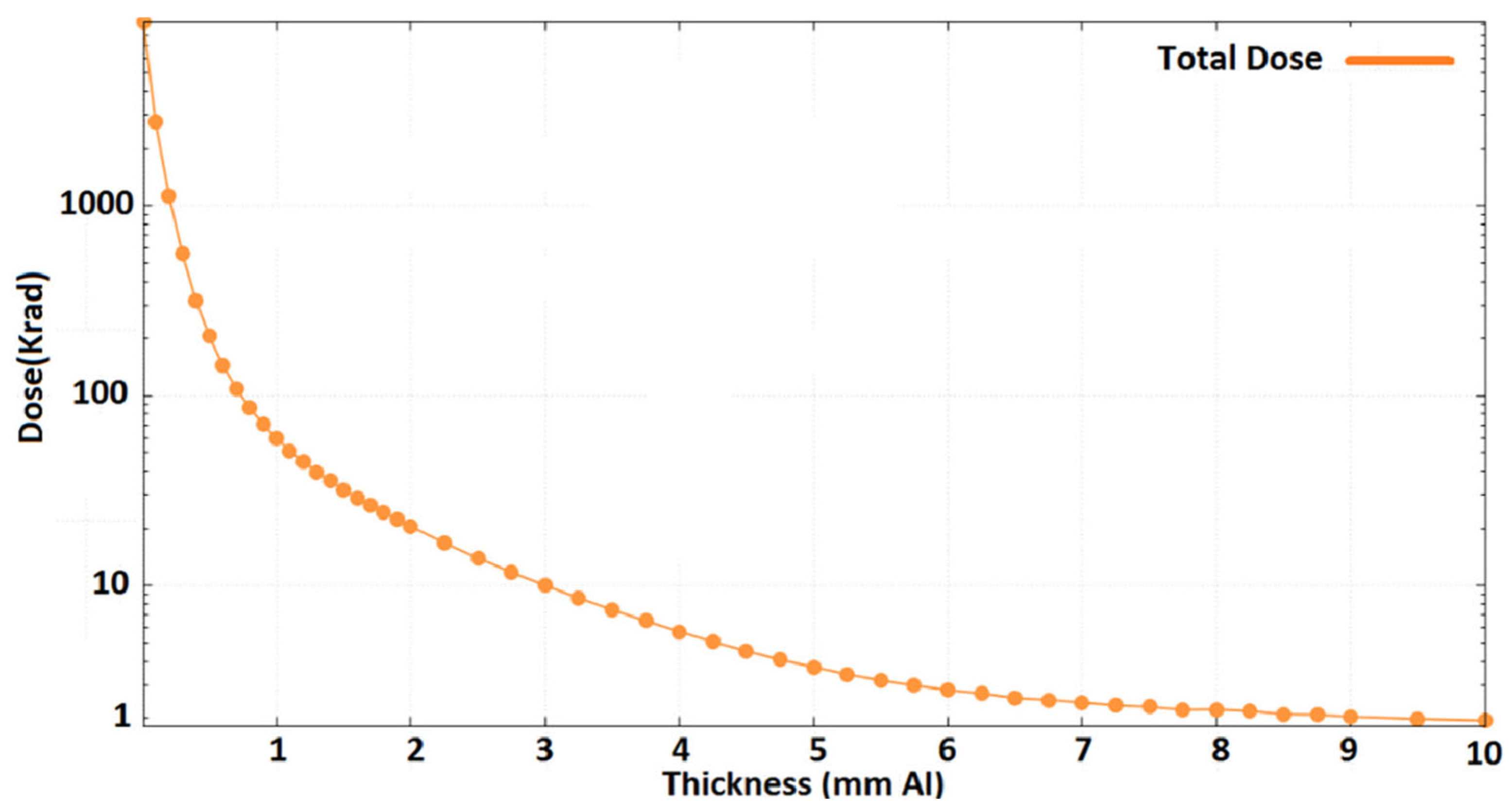
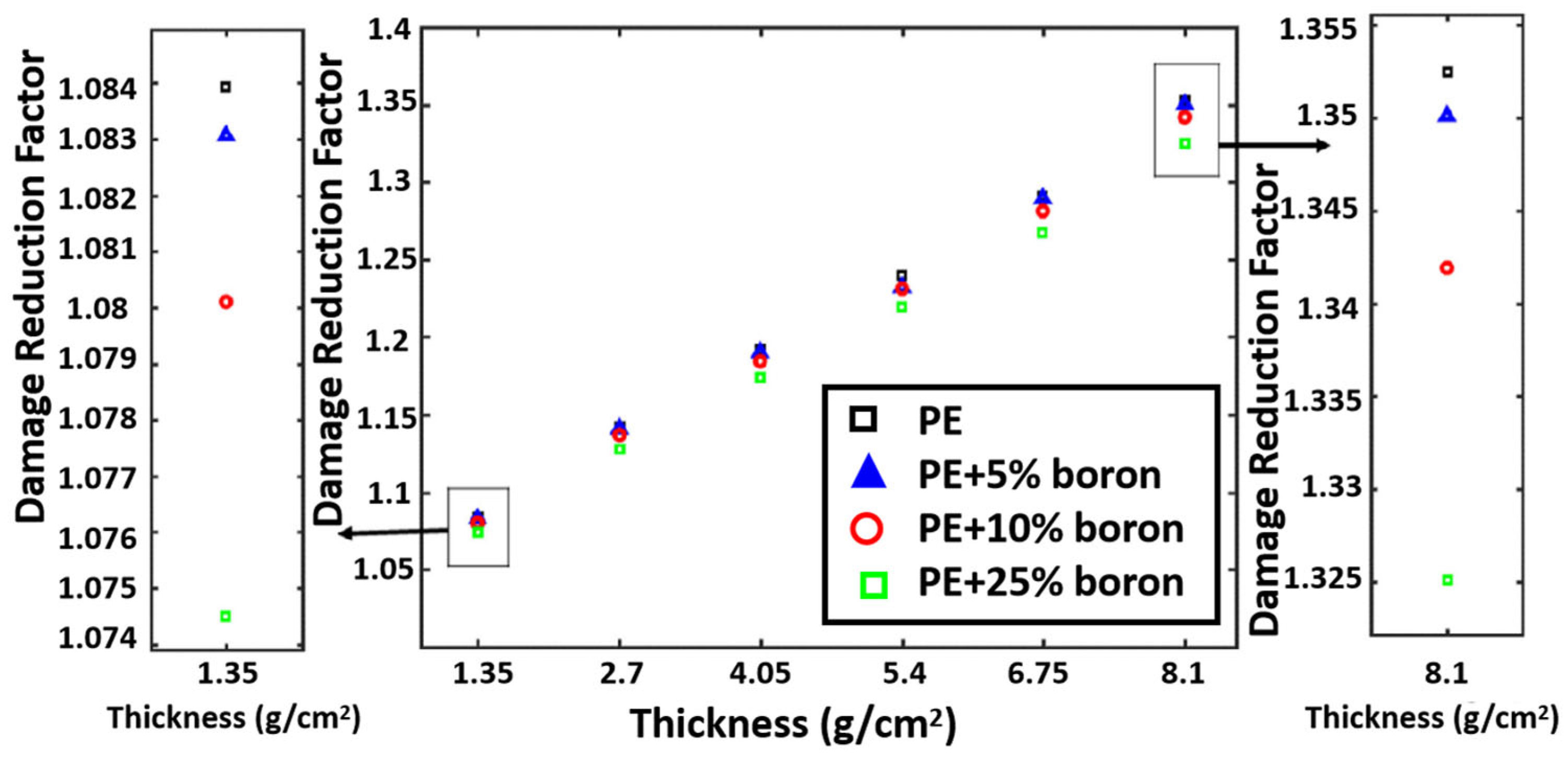
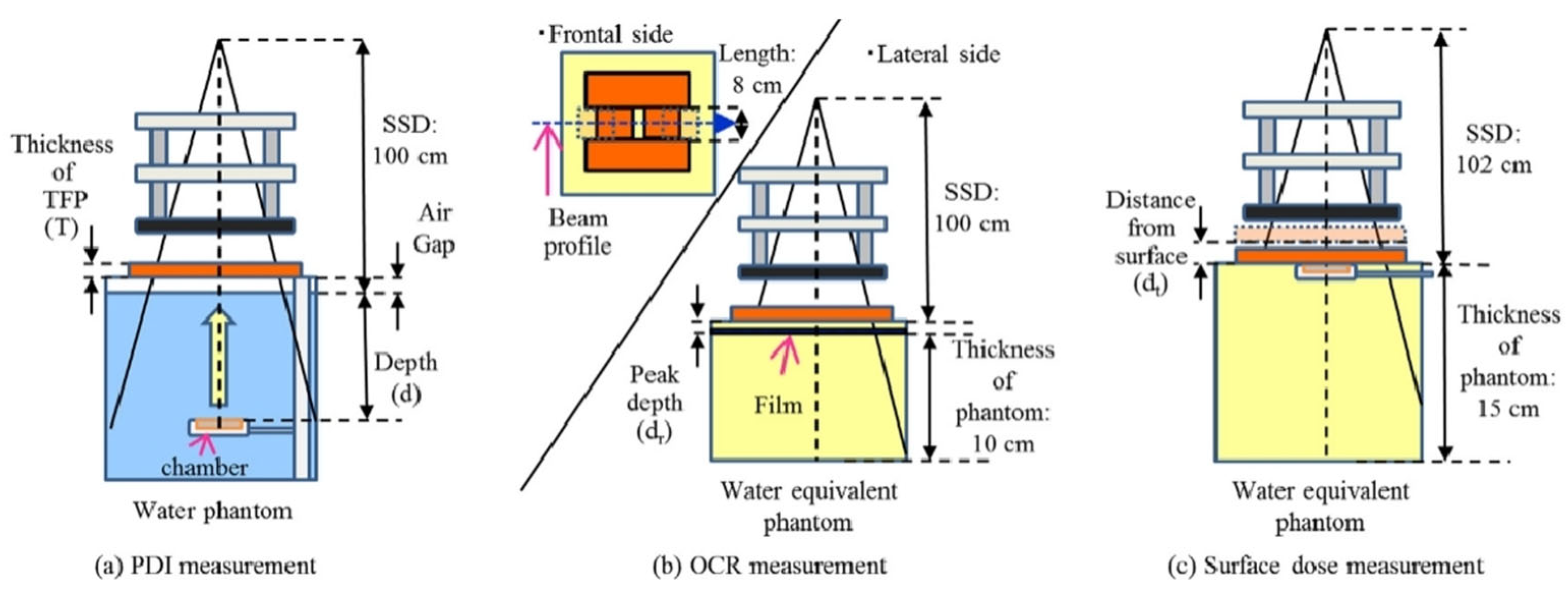
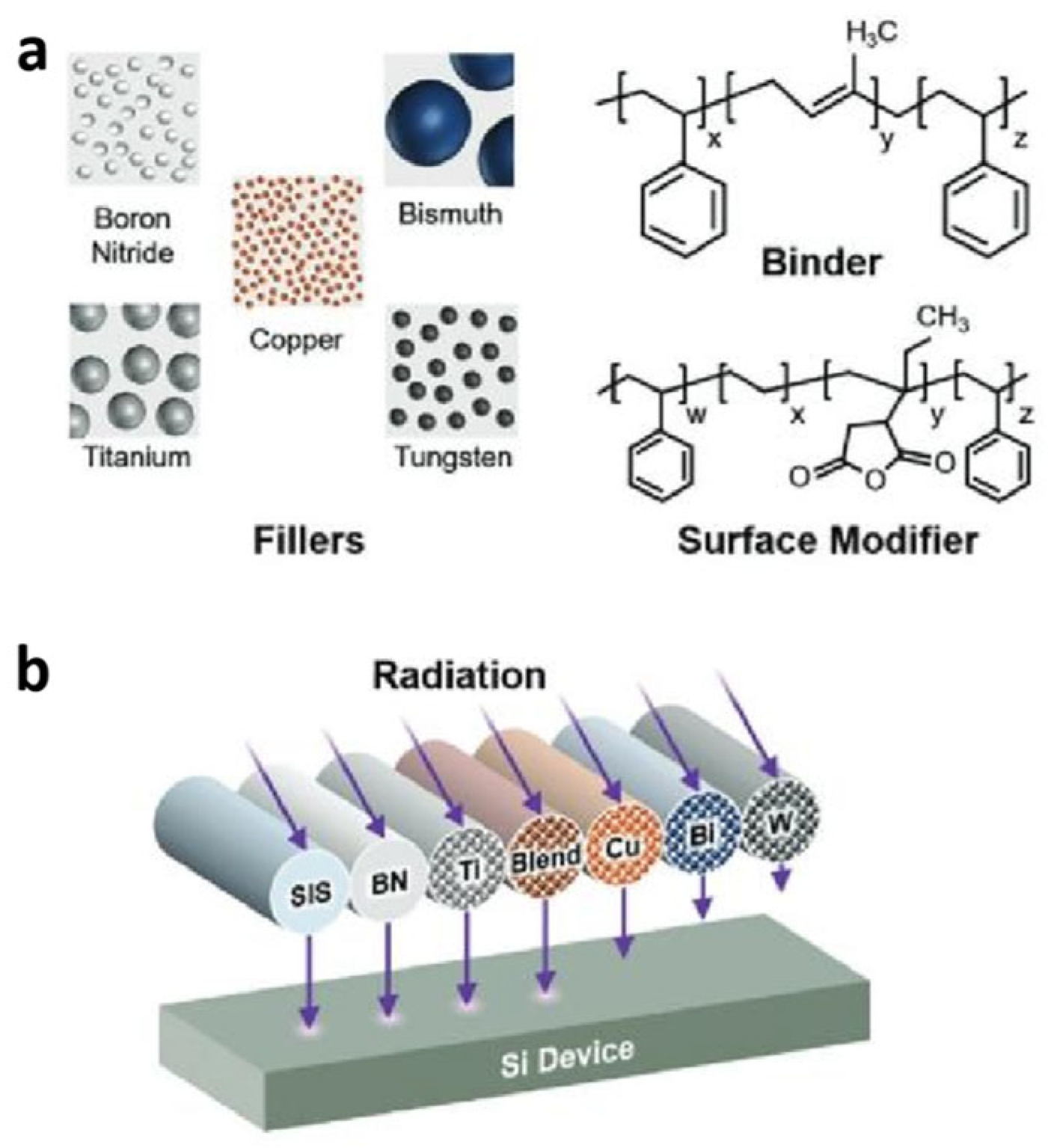
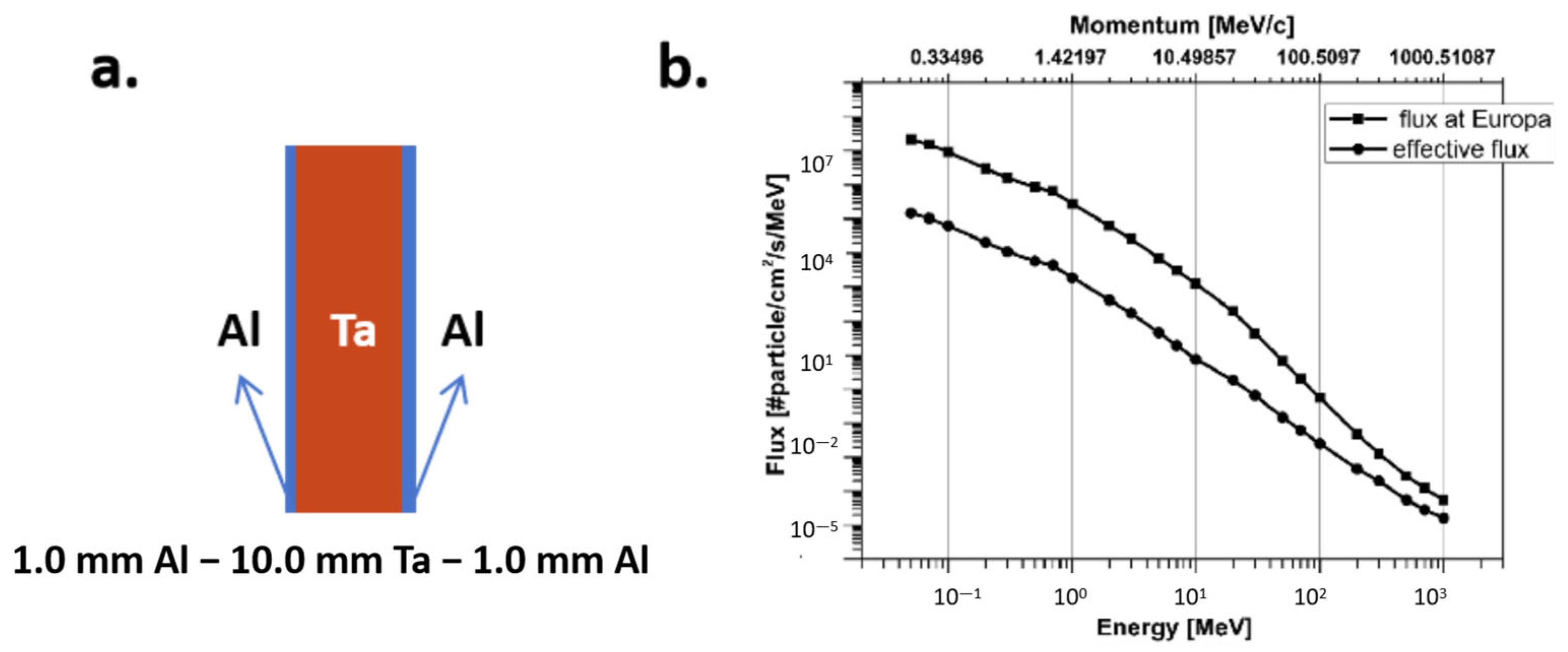

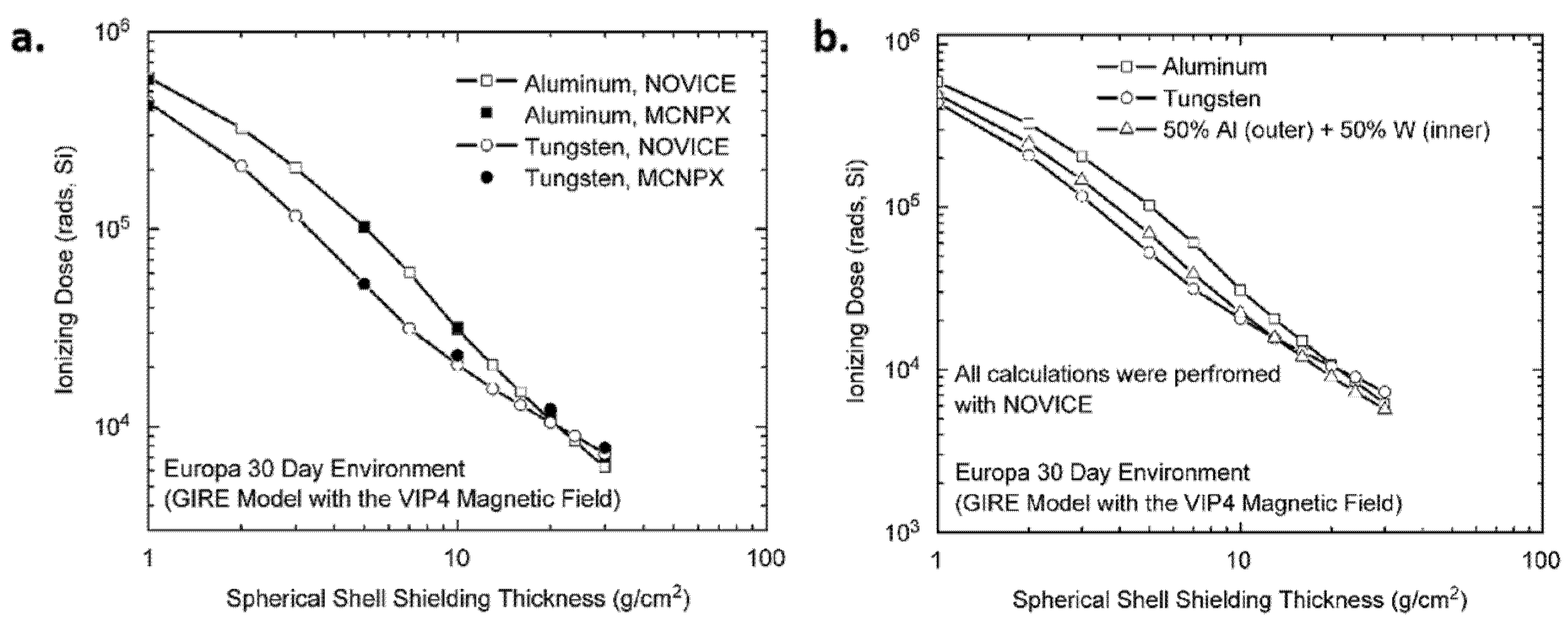
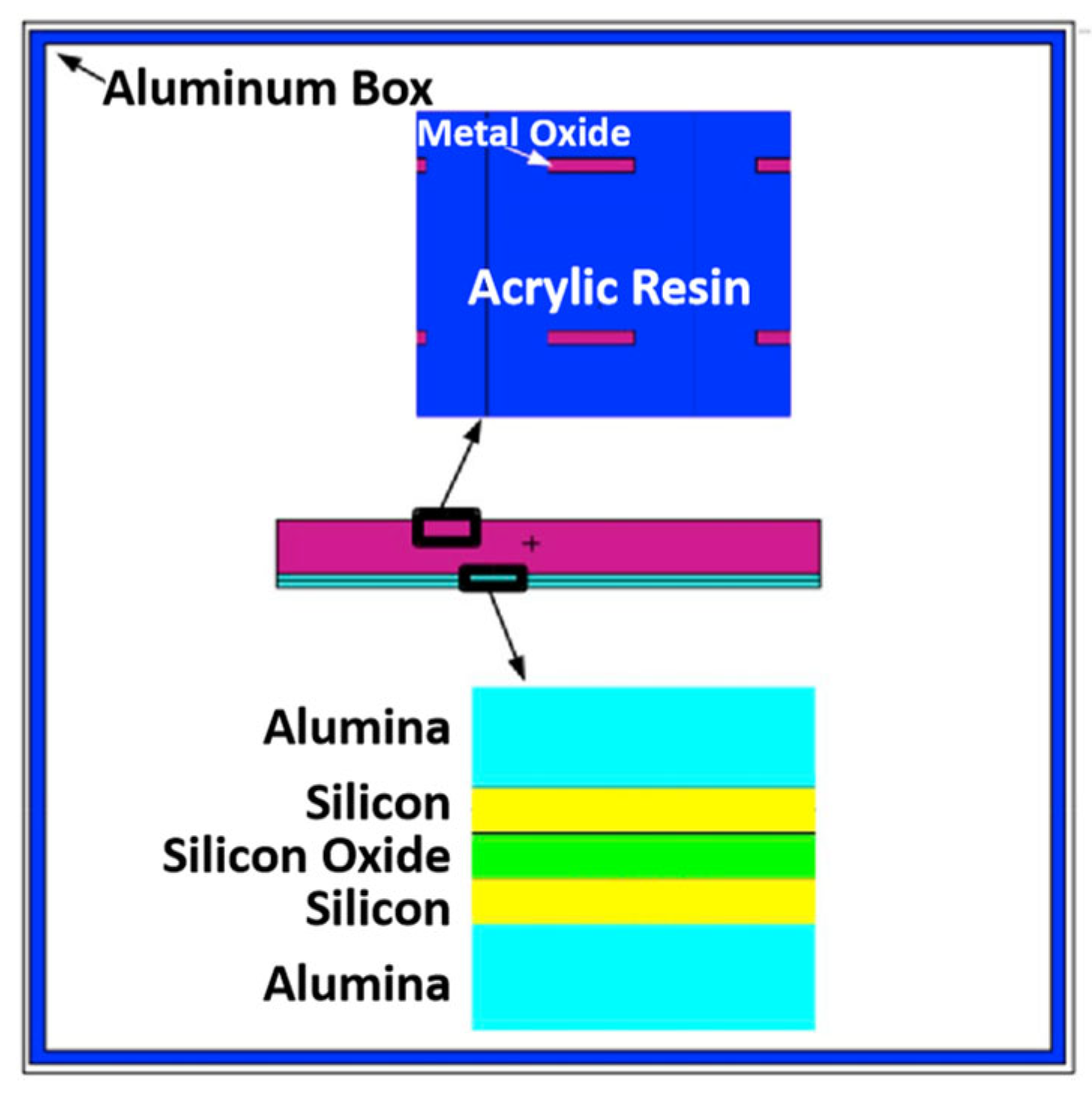
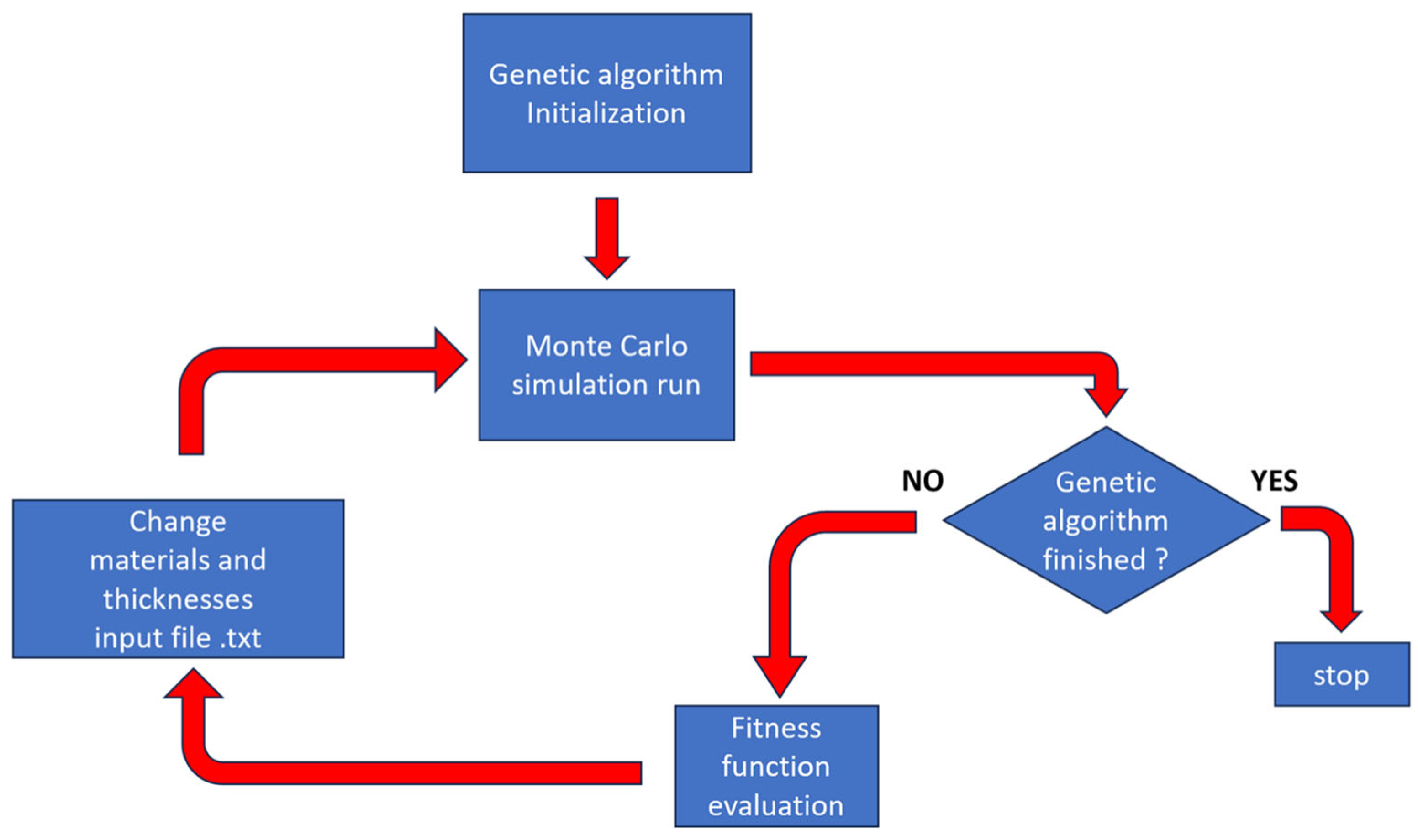
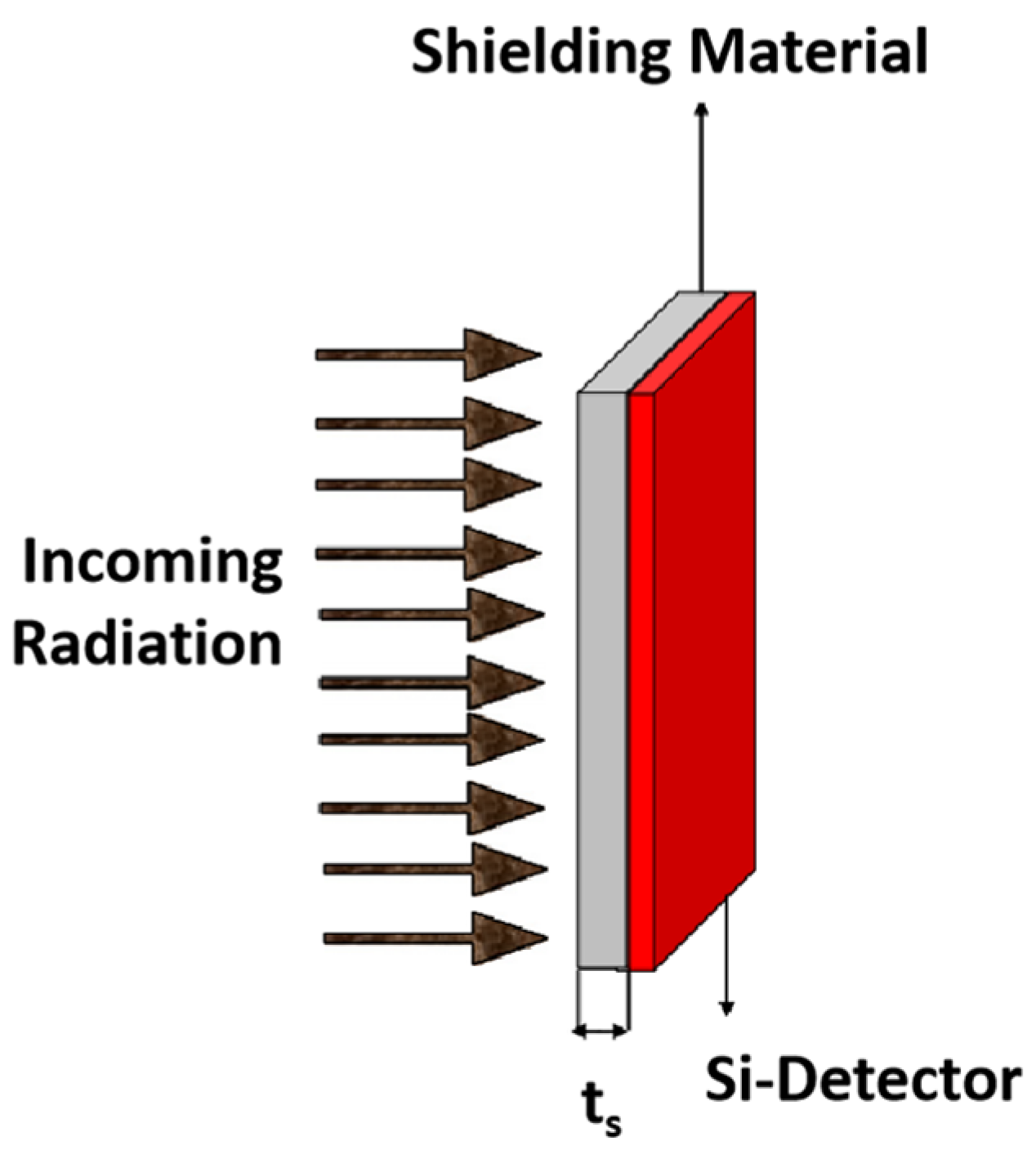
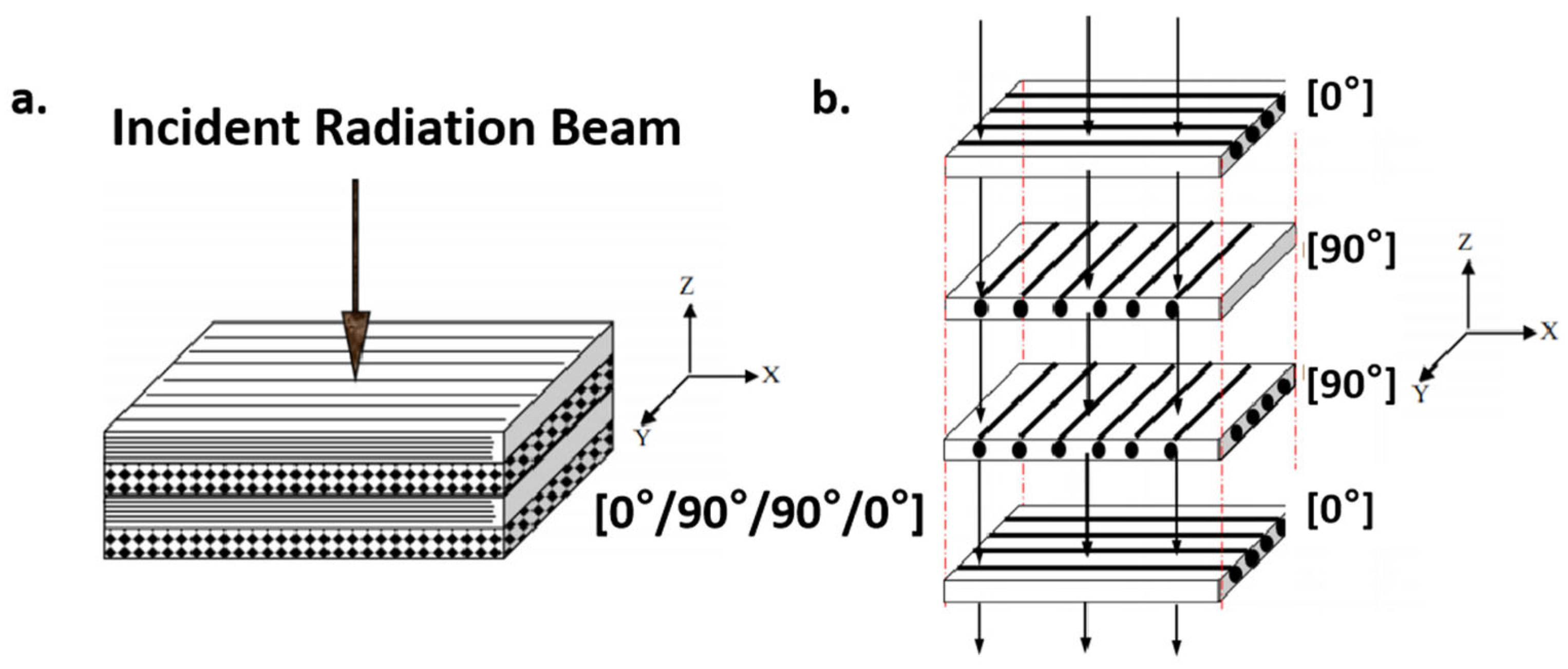

| Type of Corpuscular Radiation | Composition | Energy of Particles, MeV | Flux Density, m−2s−1 |
|---|---|---|---|
| Galactic cosmic ray | Protons, helium nuclei, and heavier nuclei | 102 to 1014 | 1.5 × 104 |
| (For all groups of nuclei) | 1 × 103 | ||
| 1.2 × 101 | |||
| Solar cosmic rays | Protons | 1 to 104 | 107 to 108 |
| Earth’s radiation belts | Protons | 1 to 30 | 3 × 1011 |
| >30 | 2 × 108 | ||
| Electrons | 0.1 to 1.0 | 1 × 1012 | |
| >1.0 | 1 × 1010 |
| Material | Atomic Number | Density (g/cm3) | Mass Efficiency | Shielding Efficiency | Cost | Manufacturability | Mechanical Properties |
|---|---|---|---|---|---|---|---|
| Al | 13 | 2.7 | High mass efficiency due to low density | Provides some shielding against high-energy electrons, but poor shielding against high-energy protons | Low cost | Excellent manufacturability, easy to process and form | Moderate strength and hardness, with good ductility and toughness |
| Polyethylene | - | 0.91 to 0.96 | High mass efficiency due to low density | Limited shielding against high-energy protons and electron | Low cost | Excellent manufacturability, can be processed using various methods | Mechanical properties vary with density: low-density polyethylene is flexible, while high-density polyethylene has higher strength and hardness |
| Pb | 82 | 11.34 | Low mass efficiency due to high density | Good shielding against high-energy electrons, but limited shielding against high-energy protons | Relatively high cost | Average manufacturability, requires special handling during processing | Soft and ductile, but with low strength |
| Fe | 26 | 7.8 | Moderate mass efficiency | Provides some shielding against high-energy electrons, but limited shielding against high-energy protons | Low cost | Excellent manufacturability, easy to process and form | High strength and hardness, with good toughness |
| W | 74 | 19.35 | Low mass efficiency due to high density | Good shielding against both high-energy electrons and protons, but requires thicker material to achieve ideal shielding | High cost | Poor manufacturability, difficult to process | Very high strength and hardness, but also brittle |
| Ta | 73 | 22.59 | Low mass efficiency due to high density | Good shielding against both high-energy electrons and protons, but requires thicker material to achieve ideal shielding | High cost | Poor manufacturability, difficult to process | High strength and hardness, with good toughness |
| Material | Min Thickness (cm) | Max Thickness (cm) | Step (cm) | Density [g/cm3] |
|---|---|---|---|---|
| B4C | 2.0 | 10.0 | 2.0 | 2.52 |
| LiF | 2.0 | 10.0 | 2.0 | 2.64 |
| Paraffin | 2.0 | 10.0 | 2.0 | 0.93 |
| Polyethylene | 2.0 | 10.0 | 2.0 | 0.94 |
| Borotron | 2.0 | 10.0 | 2.0 | 1.00 |
| Al | 2.0 | 10.0 | 2.0 | 2.70 |
| Ta | 0.2 | 1.0 | 0.2 | 16.65 |
| W | 0.2 | 1.0 | 0.2 | 19.30 |
| Pb | 0.2 | 1.0 | 0.2 | 11.35 |
| Cu | 0.2 | 1.0 | 0.2 | 8.96 |
| Fe | 0.2 | 1.0 | 0.2 | 7.87 |
Disclaimer/Publisher’s Note: The statements, opinions and data contained in all publications are solely those of the individual author(s) and contributor(s) and not of MDPI and/or the editor(s). MDPI and/or the editor(s) disclaim responsibility for any injury to people or property resulting from any ideas, methods, instructions or products referred to in the content. |
© 2025 by the authors. Licensee MDPI, Basel, Switzerland. This article is an open access article distributed under the terms and conditions of the Creative Commons Attribution (CC BY) license (https://creativecommons.org/licenses/by/4.0/).
Share and Cite
Wang, M.; Wang, Q.; Xiao, Y.; Wang, M.; Wang, J.; Wang, H.; Chen, Z. Review of Passive Shielding Materials for High-Energy Charged Particles in Earth’s Orbit. Materials 2025, 18, 2558. https://doi.org/10.3390/ma18112558
Wang M, Wang Q, Xiao Y, Wang M, Wang J, Wang H, Chen Z. Review of Passive Shielding Materials for High-Energy Charged Particles in Earth’s Orbit. Materials. 2025; 18(11):2558. https://doi.org/10.3390/ma18112558
Chicago/Turabian StyleWang, Mingxin, Qian Wang, Yakai Xiao, Mingliang Wang, Jianwei Wang, Haowei Wang, and Zhansheng Chen. 2025. "Review of Passive Shielding Materials for High-Energy Charged Particles in Earth’s Orbit" Materials 18, no. 11: 2558. https://doi.org/10.3390/ma18112558
APA StyleWang, M., Wang, Q., Xiao, Y., Wang, M., Wang, J., Wang, H., & Chen, Z. (2025). Review of Passive Shielding Materials for High-Energy Charged Particles in Earth’s Orbit. Materials, 18(11), 2558. https://doi.org/10.3390/ma18112558






